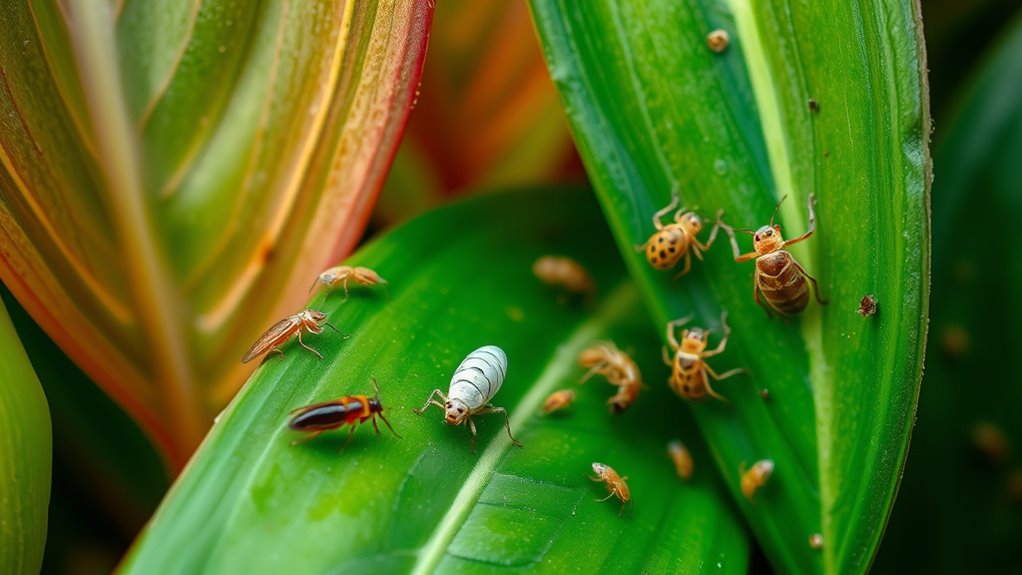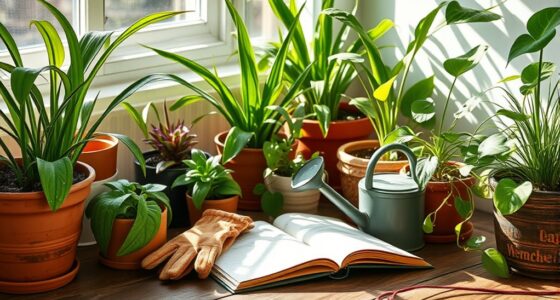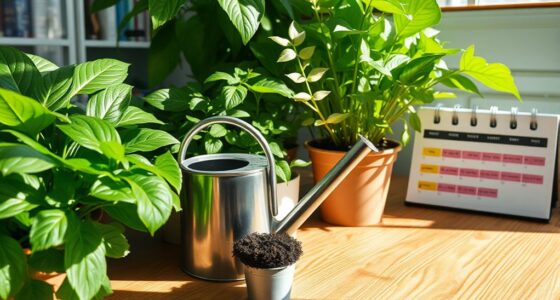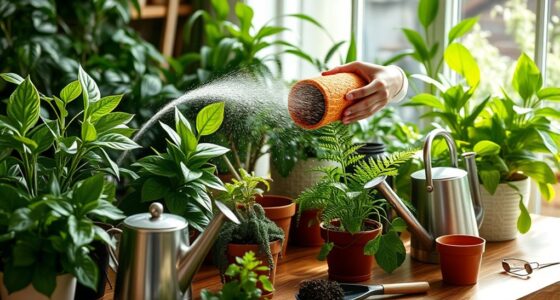To spot pests like thrips, mites, and mealybugs on your houseplants, look for signs like silvery streaks, stippling, or distorted leaves. Thrips are tiny, fast-moving insects with fringed wings, often fluttering when disturbed, and leave black specks of waste. Check by tapping plants over a white surface to see pests or debris. Early detection helps control damage; continue exploring to learn detailed identification tips and prevention strategies.
Key Takeaways
- Thrips are tiny, slender insects less than ¼ inch, with fringed wings causing silvery streaks on leaves.
- Look for silvery patches, distorted foliage, and black waste spots as signs of thrips infestation.
- Detect thrips by shaking plants over white paper and observing small, fast-moving insects and fluttering wings.
- Early identification and isolation are crucial for controlling thrips and preventing plant virus spread.
- Regularly inspect houseplants and act promptly with appropriate control measures to manage pests effectively.

Thrips are tiny, slender insects, often less than a quarter-inch long, with fringed wings that flutter around your plant. You might notice silvery streaks or stippling on the leaves where they feed — these are tiny punctures from their piercing mouthparts. Sometimes, the leaves develop black specks, which are thrips’ waste. If you gently shake the plant or hold a white piece of paper underneath a leaf and tap, you might see small, fast-moving thrips flutter away. Their presence can cause your plants’ foliage to look distorted or develop silvery patches, especially on new growth. Thrips also spread viruses, so quick identification helps prevent further issues. Recognizing these pests early can help you take appropriate control measures before they cause significant damage.
Frequently Asked Questions
How Can I Prevent Pests From Infesting New Houseplants?
To prevent pests from infesting your new houseplants, always inspect them thoroughly before bringing them inside. Quarantine new plants for a week to monitor for pests, and wash leaves with a gentle spray of water or a mild soap solution. Use clean pots and fresh soil, and avoid overwatering. Regularly check your plants for early signs of pests, so you can catch and treat issues promptly.
Are There Natural Remedies for Pest Control That Are Safe Indoors?
Think of natural pest remedies as your plant’s gentle shield. You can spray a mixture of neem oil and water, which acts like a botanical armor against pests. Introduce ladybugs or lacewing insects to your indoor garden—they’re like tiny, helpful warriors. You might also wipe leaves with diluted alcohol or soap solutions. These methods are safe indoors and keep pests at bay without harsh chemicals, letting your plants thrive peacefully.
What Are the Signs of Pest Infestation in the Early Stages?
You’ll notice early signs of pest infestation by looking for tiny specks or webbing on your plant’s leaves and stems. Leaves may appear discolored, curled, or distorted, and you might see sticky residue or fine silk threads. Check regularly beneath leaves and in crevices, as pests hide there. Catching these signs early helps you act quickly, preventing a full-blown infestation and keeping your houseplants healthy.
How Often Should I Inspect My Houseplants for Pests?
Think of your houseplants as living art—delicate, vibrant, and worth protecting. You should inspect your plants at least once a week, especially when the seasons change or if you notice any signs of distress. Look closely at the undersides of leaves, stems, and soil surface. Regular checks act like a health scan, catching pests early before they can cause serious damage and ensuring your plants stay thriving and beautiful.
Can Pests Spread Between Different Types of Houseplants?
Yes, pests can spread between different types of houseplants. When you handle or move plants without cleaning your hands or tools, pests can hitch a ride from one plant to another. Overcrowding or poor airflow also encourages pest movement. To prevent this, inspect each plant regularly and isolate new or infested plants. Proper sanitation and monitoring help stop pests from spreading and protect your entire collection.
Conclusion
Don’t let pests scare you into giving up on your houseplants. With this ID guide, you’ll spot thrips, mites, and mealybugs early and take action fast. Sure, pest problems can seem overwhelming, but every plant owner faces them at some point. Just stay vigilant, act quickly, and your houseplants will thrive. Remember, a little bit of pest management now keeps your green friends healthy and happy for years to come.











